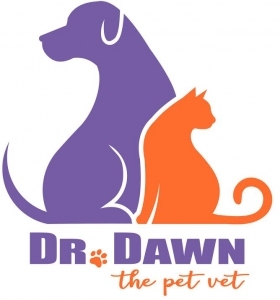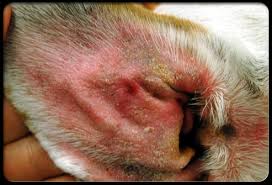 Even though I already wrote a post a few months ago regarding allergies with pets, read this one as well. This post contains different information, with some more details about specific treatments, etc. As we are coming into Spring, a common season of allergies for pets and the humans in their lives as well, I thought it a timely topic. It is definitely one that I spend much time discussing this time of the year. So today, I thought I would let my fingers do the talking.
Even though I already wrote a post a few months ago regarding allergies with pets, read this one as well. This post contains different information, with some more details about specific treatments, etc. As we are coming into Spring, a common season of allergies for pets and the humans in their lives as well, I thought it a timely topic. It is definitely one that I spend much time discussing this time of the year. So today, I thought I would let my fingers do the talking.
Seasonal allergies are a common cause of skin problems in dogs, and are seen, but are less common in cats. It is also called atopy, or atopic dermatitis, or even allergic inhalant dermatitis. They all refer to the same thing, which is when allergens that are inhaled or that contact the skin cause an allergic reaction in the body. In dogs, this reaction is focused largely in the skin. These animals become very itchy; the resultant scratching leads to skin injuries and secondary skin infections. It is usually first noticed in dogs younger than 3 years of age, although older pets can also be affected. Unfortunately, pets that develop atopy are usually plagued by skin and/or ear problems throughout their lives.
Many types of allergens can cause a pet to develop atopy. A wide variety of pollens, grasses, danders, insect proteins (such as in cockroaches), molds, and even house dust can cause animals to develop signs. They may even develop allergies to multiple allergens at the same time. Once atopy develops, the condition will continue as long as the animal is exposed to the allergen.
Signs of Atopy
Although technically atopy involves the entire body, clinical signs tend to involve the skin: namely the face, armpits, groin, ears, and feet. Persistent itching causes the pet to lick,chew, scratch, and/or rub the skin, causing injury. Secondary bacterial or yeast skin infections are common. Clinical signs may include:
-generalized scratching and rubbing
-redness of the skin
-hair loss from repeated biting, licking, chewing, and/or scratching
-skin rash, infections, and irritation
-scabs and bleeding
-unusual odor
-skin thickening and color changes
-scales and crusts on the skin.
Some animals may have several of these clinical signs, others may have only one.
Diagnosis and Treatment
This can be complicated, partly because other skin problems, such as flea allergy dermatitis, may look very similar. Your veterinarian will likely ask you questions about your pet’s medical history to try to determine the duration or seasonality of the problem, vs. a year-round issue. You may also be asked questions about your pet’s diet and any products you may be using on your pet or in your home (shampoos, detergents). Medicals test may be recommended to help rule out other skin conditions (such as skin mites), prior to ultimately making the diagnosis of atopy.
Allergy Testing and Immunotherapy
Allergy tests can help identify the specific allergens that ay be at the root of a pet’s skin problems. This may not be the first thing done once you arrive at your veterinarian. It is something that will likely be recommended if your dog suffers frequently from allergies, and severely. There are 2 types of testing: intradermal skin tests and serum allergy tests.
Intradermal skin testing: These tests are typically not done in your regular vet’s office. Veterinary dermatologists often perform these tests. First fur is shaved from an area on your pet to expose enough skin to test. Then tiny injections of each allergen are given under the skin. After a brief waiting period, your veterinarian will examine the sites to determine if there is a reaction, indicating allergies to those allergens, and the severity.
Serum Allergy Testing: This is becoming more popular, as it is much easier to perform. Blood samples are taken, and the testing is performed in a lab, on the blood. No shaving nor injections are necessary.
Both tests may require the cessation of allergy medication prior to testing. Both, if allergies are found, will lead to the development of patient specific serum containing small quantities of these allergens. Through injections of the allergy serum over time, many pets experience a reduced response to the allergens. This is called immunotherapy treatment, and is generally continued for several months to years to achieve results. Typically the owner is taught how to administer the injections at home.The first injections are more diluted, and each subsequent injection has a slightly higher concentration of the allergens. Your vet will give you a chart of guidelines to follow. Many pets, but not all, respond to this program. Those with other underlying conditions may not respond.
This tends to be a long-term condition, often requiring a combination of therapies.
1. Remove allergens from the environment: Ideally, if your pet is allergic to a specific item, such as wool, this is easy enough. Unfortunately, this is not always possible or practical, as some grasses and trees may be so common where you live that there is not way to reduce or eliminate exposure to them. But, when possible, do what you can. Eg. make your home as clean and dust free if your pet has a dust mite allergy. Air filters are also helpful to remove dust, pollens, and other airborne allergens. Also, control fleas, a common allergen.
2. Treat the symptoms: For some atopic pets, the itching can be relentless. Immunotherapy and other management options take time to go into effect, so relief is often needed immediately. Discuss with your vet:
-Steroids (corticosteroids) are often indicated for severe itching. They are better in the short term, and should be avoided for long term use if possible, as they have side effects such as increased appetite, thirst and urination. Long term use can increase the risk of other medical problems, such as liver issues, adrenal gland problems and diabetes. They are available in many forms (injection, by mouth, shampoos, topical sprays or ointments).
– Antihistamines, such as diphenhydramine (Benadryl) have less side effects than corticosteroids. However, some pets will not respond to antihistamines alone. Also, it may take trial and error to find an antihistamine that works better than the others for your pet. Many are over the counter. Your vet should guide you to the appropriate dose.
-Fatty acid supplements may hall reduce skin inflammation and are often used in combination with other medications.
-Topical treatments, such as medicated shampoos, may help relieve itching and secondary conditions you may also see, such as fungal infections, bacterial infections and scaling. Follow your vet’s directions regarding type and frequency of use.
-Antibiotics are often indicated, such as when a secondary infection has resulted. Ear infections are common aspects of atopic disease, and specific cleaners and ear medications will be dispensed based on the type of infection present.
-Cyclosporine is sometimes used to control atopic dermatitis in dogs. It is another anti-inflammatory medication, that would have specific instructions on how to dose it and taper off the medication. It also has side effects associated with it’s use (gastrointestinal).
I find it helpful to try to determine what seasons your dog has shown symptoms of allergies in the past. Then, when that season approaches, be extra vigilant and proactive in attempting to relieve the itching at home, hopefully without even needing a visit to your vet. But, if that alone is ineffective, getting to your vet as soon as you are able.
Dr. Dawn
Please subscribe and share here






